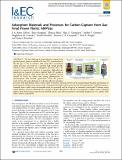Files in this item
Adsorption materials and processes for carbon capture from gas-fired power plants : AMPGas
Item metadata
| dc.contributor.author | Gibson, J. A. Arran | |
| dc.contributor.author | Mangano, Enzo | |
| dc.contributor.author | Shiko, Elenica | |
| dc.contributor.author | Greenaway, Alex | |
| dc.contributor.author | Gromov, Andrei V. | |
| dc.contributor.author | Lozinska, Magdalena M. | |
| dc.contributor.author | Friedrich, Daniel | |
| dc.contributor.author | Campbell, Eleanor E. B. | |
| dc.contributor.author | Wright, Paul A. | |
| dc.contributor.author | Brandani, Stefano | |
| dc.date.accessioned | 2016-04-07T11:00:06Z | |
| dc.date.available | 2016-04-07T11:00:06Z | |
| dc.date.issued | 2016-04-06 | |
| dc.identifier | 241575629 | |
| dc.identifier | fc73ed12-191e-425d-a072-c5ee0b7811ed | |
| dc.identifier | 84963967666 | |
| dc.identifier | 000373748300015 | |
| dc.identifier.citation | Gibson , J A A , Mangano , E , Shiko , E , Greenaway , A , Gromov , A V , Lozinska , M M , Friedrich , D , Campbell , E E B , Wright , P A & Brandani , S 2016 , ' Adsorption materials and processes for carbon capture from gas-fired power plants : AMPGas ' , Industrial & Engineering Chemistry Research , vol. 55 , no. 13 , pp. 3840–3851 . https://doi.org/10.1021/acs.iecr.5b05015 | en |
| dc.identifier.issn | 0888-5885 | |
| dc.identifier.other | RIS: urn:FE0824AEED1BC6B260A209ED4E32822F | |
| dc.identifier.other | ORCID: /0000-0002-4243-9957/work/62668244 | |
| dc.identifier.uri | https://hdl.handle.net/10023/8572 | |
| dc.description | Financial support from the EPSRC AMPGas project EP/J0277X/1 is gratefully acknowledged | en |
| dc.description.abstract | The key challenge in postcombustion capture from gas-fired power plants is related to the low CO2 concentration in the flue gas (4–8% by volume). This means that conventional amine processes will result in a relatively high energy penalty, whereas novel adsorbents and adsorption processes have the potential to improve the efficiency of separation. High-selectivity adsorbents are required to achieve relatively high CO2 uptake at low partial pressures, which means that the separation process should be based on either very strong physisorption or chemisorption with thermal regeneration. From the process point of view, the main challenge is to develop efficient separation processes with rapid thermal cycles. In this report we present a detailed overview of the methodology behind the development of novel materials and processes as part of the “Adsorption Materials and Processes for Gas-fired power plants” (AMPGas) project. Examples from a wide variety of materials tested are presented, and the design of an innovative bench-scale 12-column rotary wheel adsorber system is discussed. The strategy to design, characterize, and test novel materials (zeolites, amine-containing MOFs, amine-based silicas, amine-based activated carbons, and carbon nanotubes), specifically designed for CO2 capture from dilute streams is presented. | |
| dc.format.extent | 5993667 | |
| dc.language.iso | eng | |
| dc.relation.ispartof | Industrial & Engineering Chemistry Research | en |
| dc.subject | QD Chemistry | en |
| dc.subject | DAS | en |
| dc.subject.lcc | QD | en |
| dc.title | Adsorption materials and processes for carbon capture from gas-fired power plants : AMPGas | en |
| dc.type | Journal article | en |
| dc.contributor.sponsor | EPSRC | en |
| dc.contributor.institution | University of St Andrews. School of Chemistry | en |
| dc.contributor.institution | University of St Andrews. EaSTCHEM | en |
| dc.identifier.doi | 10.1021/acs.iecr.5b05015 | |
| dc.description.status | Peer reviewed | en |
| dc.identifier.grantnumber | EP/J02077X/1 | en |
This item appears in the following Collection(s)
Items in the St Andrews Research Repository are protected by copyright, with all rights reserved, unless otherwise indicated.

